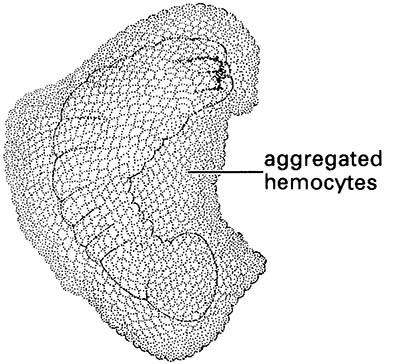13.2.3. Overcoming host immune responses
Insects that develop within the body of other insects must cope with the active immune responses of the host. An adapted or compatible parasitoid is not eliminated by the cellular immune defenses of the host. These defenses protect the host by acting against incompatible parasitoids, pathogens, and biotic matter that may invade the host’s body cavity. Host immune responses entail mechanisms for (i) recognizing introduced material as non-self, and (ii) inactivating, suppressing, or removing the foreign material. The usual host reaction to an incompatible parasitoid is encapsulation, i.e. surrounding the invading egg or larva by an aggregation of hemocytes (Fig. 13.5). The hemocytes become flattened onto the surface of the parasitoid and phagocytosis commences as the hemocytes build up, eventually forming a capsule that surrounds and kills the intruder. This type of reaction rarely occurs when parasitoids infect their normal hosts, presumably because the parasitoid or some factor(s) associated with it alters the host’s ability to recognize the parasitoid as foreign and/or to respond to it. Parasitoids that cope successfully with the host immune system do so in one or more of the following ways:
- Avoidance — for example, ectoparasitoids feed externally on the host (in the manner of predators), egg parasitoids lay into host eggs that are incapable of immune response, and many other parasitoids at least temporarily occupy host organs (such as the brain, a ganglion, a salivary gland, or the gut) and thus escape the immune reaction of the host hemolymph.
- Evasion — this includes molecular mimicry (the parasitoid is coated with a substance similar to host proteins and is not recognized as non-self by the host), cloaking (e.g. the parasitoid may insulate itself in a membrane or capsule, derived from either embryonic membranes or host tissues; see also “subversion” below), and/or rapid development in the host.
- Destruction — the host immune system may be blocked by attrition of the host such as by gross feeding that weakens host defense reactions, and/or by destruction of responding cells (the host hemocytes).
- Suppression — host cellular immune responses may be suppressed by viruses associated with the parasitoids (Box 13.1); often suppression is accompanied by reduction in host hemocyte counts and other changes in host physiology.
- Subversion — in many cases parasitoid development occurs despite host response; for example, physical resistance to encapsulation is known for wasp para- sitoids, and in dipteran parasitoids the host’s hemocytic capsule is subverted for use as a sheath that the fly larva keeps open at one end by vigorous feeding. In many parasitic Hymenoptera, the serosa or trophamnion associated with the parasitoid egg fragments into individual cells that float free in the host hemolymph and grow to form giant cells, or teratocytes, that may assist in overwhelming the host defenses.
Obviously, the various ways of coping with host immune reactions are not discrete and most adapted parasitoids probably use a combination of methods to allow development within their respective hosts. Parasitoid—host interactions at the level of cellular and humoral immunity are complex and vary greatly among different taxa. Our understanding of these systems is still relatively limited but this field of research is producing exciting findings concerning parasitoid genomes and coevolved associations between insects and viruses.

(After Salt 1968)

